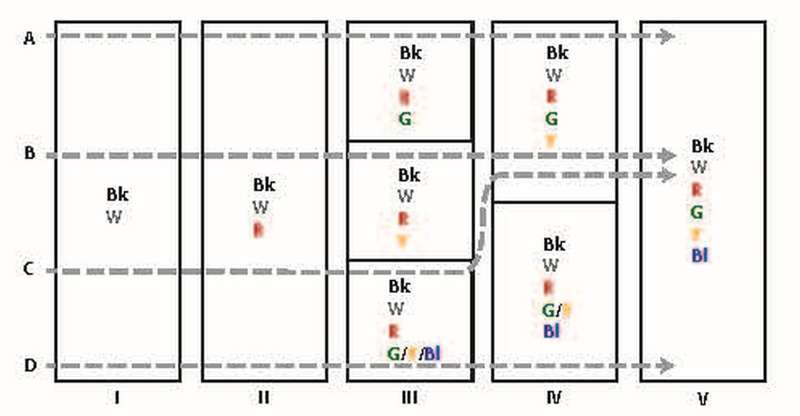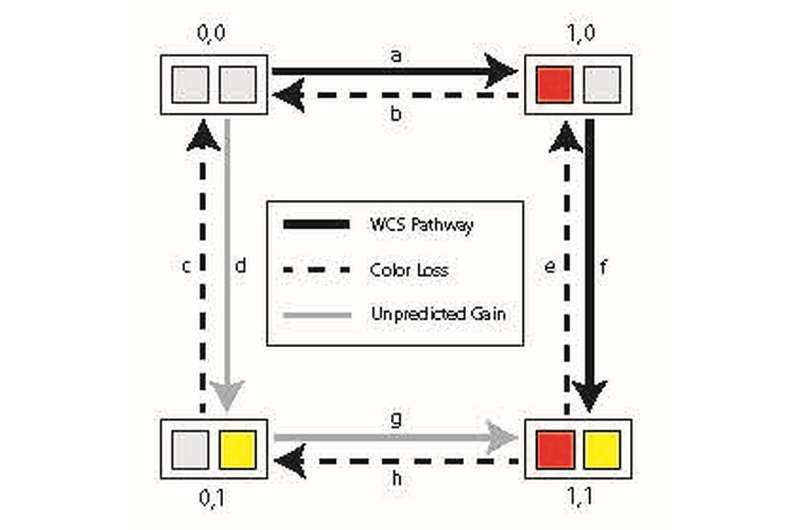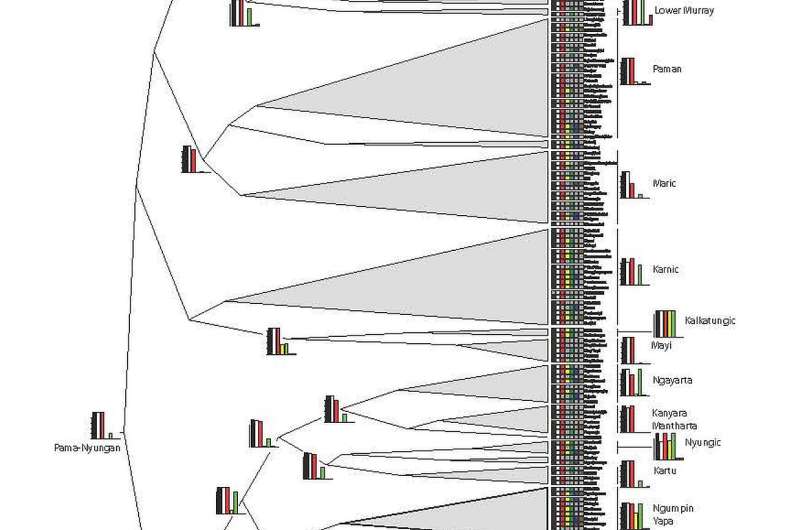Fig. 1. Evolutionary pathways of color term systems, after WCS. Haynie HJ, Bowern C (2016) Phylogenetic approach to the evolution of color term systems. Proc Natl Acad Sci USA 113(48):13666-13671.
(Phys.org)—That there are universal patterns in the naming of colors across languages has long been a topic of discussion in a range of disciplines, including anthropology, cognitive science and linguistics. However, previous color term research has not applied an evolutionary framework to the analysis of these worldwide patterns. Recently, scientists at Yale University traced the history of color systems in language by applying phylogenetic methods across a large language tree. They not only validated the phylogenetic approach to culture, but also generated a precise history of color terms across a large language sample drawn from the Pama-Nyungan languages of Australia, and moreover provided evidence supporting the loss and, as had been previously known, gain of color terms in the evolutionary process.
Prof. Claire Bowern discussed several key elements of the paper that she and Hannah J. Haynie published in the Proceedings of the National Academy of Sciences, these being:
- tracking the evolution of color terms across a large language tree in order to trace the color systems history
- validating phylogenetic approaches to culture and providing an explicit history of color terms across a large language sample when working with the Pama-Nyungan languages of Australia
- finding alternative trajectories of color term evolution beyond those considered in the standard theories
- applying Bayesian phylogenetic methods to data that bridges linguistics, cultural anthropology, and cognitive science
"We had a lot of trouble gtting data for the languages, as well as interpreting the data we had," Bowern tells Phys.org. "Since there's no preexisting set of color term datasets for these languages, we had to create it from grammars, dictionaries and field notes." Moreover, she adds, if a term wasn't in the dataset, they had to determine if it was truly absent from the language – or if it simply was not recorded in their data. The researchers also ran into difficulty deciding if a word was truly a color term, as was the case with orange, which had to be excluded from their list of colors because too many instances of the term referred only to the fruit.
"There is now a substantial body of literature on phylogenetic approaches to culture," Bowern continues. (Phylogenetics is the study of evolutionary relationships among species, individuals or genes, as modeled on trees.) "It's still somewhat controversial, but the critiques of phylogenetics outside of biology often focus on the differences between biological systems and other areas of change, such as in linguistics or culture." That said, she points out that oftentimes these critiques overlook the degree of difference among biological evolutionary processes. "It's uncontroversial that language changes; it's also uncontroversial that languages aren't organisms. The point is that from Darwin on, language and biology have had a long history of cross-pollination and co-inspiration."
Fig. 2. Parameters in dependent models. Haynie HJ, Bowern C (2016) Phylogenetic approach to the evolution of color term systems. Proc Natl Acad Sci USA 113(48):13666-13671.
Not surprisingly, then, the scientists used fairly standard techniques in phylogenetics to look at color terms to address these challenges. "We defined the problem as one in which we were comparing theories, and testing which of the theories were well-supported by our data," she explains. "For example, we compared theories where languages only lost color terms to ones where they could only gain them, or where they could both gain and lose them." They found that their data and models did not support either of the first theories, and moreover had to find ways to model our data that were computationally tractable: The number of possible parameters for computer models with seven color terms were more than could be calculated.
"Our key insights were that color terms could disappear from languages (as well as be innovated), but that this term loss is shaped by our cognitive systems. That is, our perception of the world disposes us to talk about things in certain ways. For example, humans aren't very good at smelling (compared to hearing or seeing), so it's not surprising that we don't have a lot of smell-based vocabulary. The same is true for color - the color terms that are most frequently named are (with some simplification) those that refer to regions of the color spectrum that are maximally perceptually distinct from one another. It's therefore not surprising that different languages would end up with similar color inventories. Our work shows that those same principles are at work in the ways in which color terms drop out of use.
Bowern notes that the study is relevant to a number of related disciplines, including anthropology, psychology and linguistics. "Color naming has been a central question of all these disciplines for over 100 years now," she points out. "Color was an early battleground around the idea that perception might shape language, and language perception. In essence, the debate revolved around cultural relativity and cultural differences, and whether languages that lexicalize the world in ways that differ significantly from their major European and Asian counterparts might yield crucial insights into human evolution and prehistory. "There's also been discussion about the role of material culture in leading to color naming elaboration," she adds. "An interesting example is purple, which in English originally referred to a particular type of ink, and was only later generalized as a color term that could refer to things other than ink. Our work shows how insights from historical linguistics give us a better idea about how these issues interact."
The pap theory1,2 play a substantial role in the development of color term systems, further study from an evolutionary perspective can refine our understanding of the interaction of cognitive constraints and language change in shaping lexical system.
"Perhaps an analogy with numbers would be useful," Bowern suggests. "It's not surprising that so many languages have a base ten system for counting, because the ease of counting on fingers and toes makes that a very salient choice. However, languages change over time through sound and word change, and so in many languages we find clear base ten systems being obscured." In English, she illustrates the relationship between the words three and thirty isn't as clear as the relationship between eight and eighty. "We thought the same might be true for color – that is, while there might be cognitive constraints that lead humans to name colors in a certain way, we would also expect regular principles of language, particularly semantic, to apply – and indeed, that's what we find: The cognitive constraints provide a framework for the types of colors that tend to appear, but languages acquire and change their color words from many sources. In short, color terms undergo broadening and narrowing, as other words do – but they do so within a framework that constrains the organization of the system."
Fig. 3. Ancestral state reconstructions on consensus tree. Haynie HJ, Bowern C (2016) Phylogenetic approach to the evolution of color term systems. Proc Natl Acad Sci USA 113(48):13666-13671.
Since the paper addresses the links between perception, language, and the categorization of the natural world, Phys.org asked Bowern if more detailed perception of the environmental color spectrum leads to corresponding terms (a structural evolutionary change in the ascending visual pathway), or if terminology comes first in agglutinative languages as a complex form combining a color with a function.
"I assume that it's driven by terminology," Bowern says. "Remember that this is not about what can be perceived – people can perceive color differences that they don't have words for, and perception varies between individuals even when the color lexicon does not. However, within terminological change, there might be several different ways that the change could proceed. Perhaps as a term becomes more specialized to a part of a color range, an additional term is analogically brought into the system. Or, conversely, as a term becomes analogically applied to color, another term's range is contracted." Bowern notes that the researchers did not find evidence in the Australian data for compound colors, such as light red.
Another interesting question is the dissociation between color perception and language in color blindness. "This is a good illustration of why we should usually look at the population/language level, rather than at specific individual speakers. A language still contains a word for red and green, even if some fraction of the population cannot distinguish those colors. We still have a vocabulary for music, even though some people are tone deaf. However, one could imagine a hypothetical language or dialect where enough people are color blind that those colors come to be called by the same name – but that hasn't happened in our data set."
Bowern's research group currently has work-in-progress in several aspects of language change related to both Australian languages, and language documentation and change in other regions. Specifically, they're investigating ways to use computer tools to produce sound and text-aligned recordings – that is, align a recorded story with and words in the corresponding transcription. "This is incredibly useful for language research," she tells Phys.org. Bowern is also continuing with her work in describing Australian languages, which already has provided some surprises. "In working on Australian language trees we found that Australia has approximately 400 languages – far more than 250 languages as was previously thought."
More information: Phylogenetic approach to the evolution of color term systems, PNAS (2016) 113(48):13666-13671, doi:10.1073/pnas.1613666113
Related
1Basic Color Terms: Their Universality and Evolution, (University of California Press, Berkeley, CA)
2The World Color Survey, (CSLI Publications, Stanford, CA)
Journal information: Proceedings of the National Academy of Sciences
© 2016 Phys.org
























